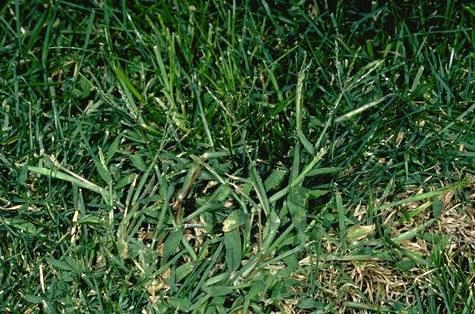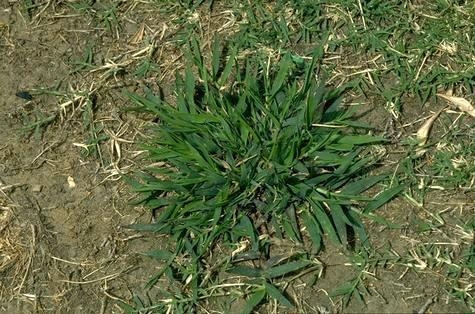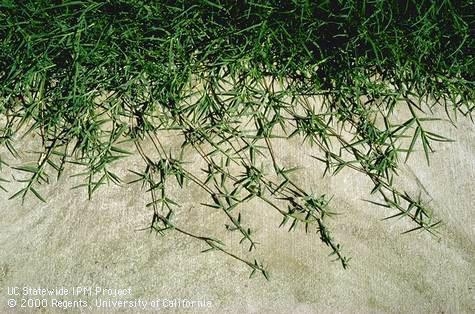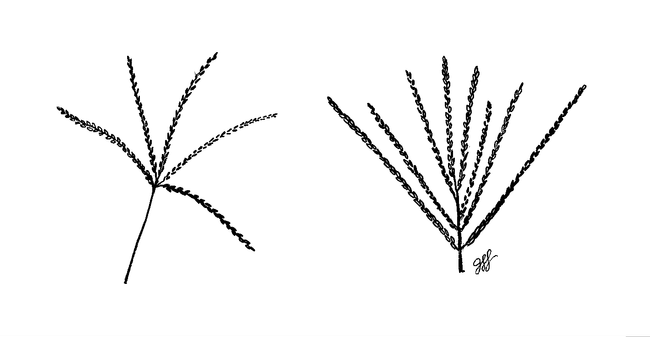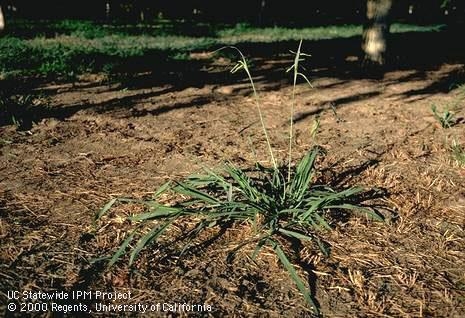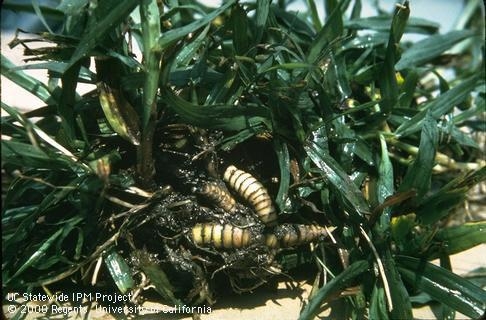[From the Spring issue of the UC IPM Retail Nursery & Garden Center News]
Fig 1. Large crabgrass. (Credit: Clyde Elmore)
Crabgrass
There are two annual weed species of crabgrass: large crabgrass and smooth crabgrass. Large crabgrass, sometimes called hairy crabgrass (Digitaria sanguinalis), has leaves that usually appear grey with a hairy upper surface (Figure 1). If unmowed, the leaf sheath can grow upright to a height of 2 feet. Large crabgrass is commonly found in gardens and landscape areas.
Fig 2. Smooth crabgrass. (Credit: Clyde Elmore)
While annual crabgrasses can be a problem, they pale in comparison to the perennial weeds bermudagrass and dallisgrass. Learn more about crabgrasses in the Pest Notes: Crabgrass.
Bermudagrass
Fig 3. The creeping stolons of bermudagrass. (Credit: Clyde Elmore)
Bermudagrass is hard to pull out and is very tolerant of both drought and mowing. The seed heads look very similar to those of crabgrass (Figure 4). Unlike the other two weeds discussed, bermudagrass can be very invasive in lawns and gardens. Learn more about bermudagrass by reading Pest Notes: Bermudagrass.
Dallisgrass
Fig 4. Flowering stems of bermudagrass (left) and crabgrass. (Illustration: Jacqueline Lockwood)
Dallisgrass is a problem in many areas because it is adapted to inconsistent irrigation and fairly close mowing; the seed heads grow almost parallel to the ground and are often missed by lawn mowers. Learn more about dallisgrass in the Pest Notes: Dallisgrass.
How do you tell them apart?
Fig 5. Mature dallisgrass plant. (Credit: Jack Kelly Clark)
How are these weeds controlled?
Because crabgrasses are annual plants, reducing the amount of shallow irrigation helps reduce their germination and growth. In gardens, use drip irrigation, which works best when buried. In lawns, replace short, daily watering with fewer but longer (deep) irrigations. This allows the top to dry out, and encourages the deep-rooted perennial lawn species growth. To manage crabgrass, raise the height of your mower; this has been shown to make lawn more competitive.
Fig 6. Dallisgrass rhizomes. (Credit: Jack Kelly Clark)
Finally, many people use “crabgrass weed and feed” for weed control. This product is a combination of lawn fertilizer and preemergence herbicide. If applied before crabgrass emerges in your lawn, it can be very effective. However, if the weeds are bermudagrass or dallisgrass, the preemergence herbicide may control some of the emerging seedlings but will not control (and may actually increase) the infestation of these two weeds.
Proper identification and knowledge of weed biology, such as germination time and life cycle, is the first step in any effective weed management attempts. For more help identifying weeds, visit the UC IPM Weed Gallery.
